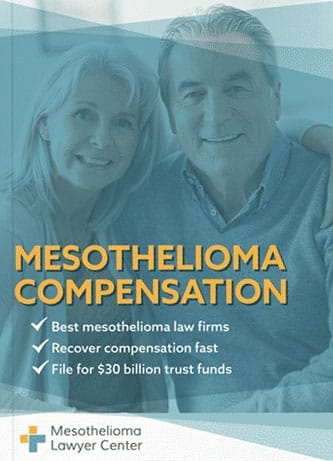Asbestos mining and even mining other minerals has caused significant asbestos exposure in workers and continues to be risky today. The Mine Safety and Health Administration regulates mine safety, but it is still a dangerous industry and workplace.
If you suffer from malignant mesothelioma, asbestosis, or asbestos-related lung cancer, you may be eligible for a large amount of compensation. Fill out our form to receive our free Financial Compensation Packet. Our packet is loaded with information on experienced mesothelioma attorneys in your area, how to file a claim for asbestos trust funds, how to get paid in 90 days, and more.


FREE Financial Compensation Packet
- Info on law firms that will recover your HIGHEST COMPENSATION
- Learn how to get paid in 90 days
- File for your share of $30 billion in trust funds
How Miners Are Exposed to Asbestos
Asbestos is a natural mineral made up of fibers. When disturbed, asbestos releases tiny fiber fragments into the air. Anyone near asbestos might inhale these fibers. This is known as asbestos exposure.
Asbestos exposure can cause serious illnesses, often decades later: mesothelioma, asbestosis, lung cancer, and other conditions.
Mining has long been considered a high-risk profession for several occupational hazards, including asbestos exposure. There are a few ways miners can be exposed to asbestos:
- Exposure in asbestos mines. Asbestos is no longer mined in the U.S. Miners who worked in asbestos mines before they closed had high risks of exposure because they handled and removed raw asbestos from deposits in the ground.
- Exposure to contaminating asbestos. Few minerals exist in the ground in isolation. They are often interspersed with each other. Miners working today might come into contact with asbestos deposits in other types of mines, such as vermiculite.
- Exposure to asbestos in machinery. The work of mining requires large machinery, equipment, and tools. Some of this equipment contains asbestos in friction parts to prevent overheating and fire. Brakes and clutches in heavy machinery are most likely to contain asbestos.
Asbestos Mining in the United States
Asbestos mining in the U.S. started at the beginning of the 20th century. It began in Georgia but expanded across the Eastern portion of the nation within the next several years.
Eventually, asbestos mining started on the West Coast, including Washington, Oregon, and California. Numerous other states followed.
Asbestos mining in the U.S. continued for years, peaking around the early 1970s. By the late 1970s, the dangers of asbestos were well known, and regulations began limiting its use. The last operating U.S. asbestos mine was in San Benito County, California, and closed in 2002.
Libby, Montana
Libby, Montana, is a small town surrounded by the Cabinet Mountains, but it’s home to large amounts of asbestos-contaminated vermiculite.
Vermiculite is a group of minerals that often contains other contaminating minerals. In Libby, one of those contaminating minerals was asbestos.
Mining in Libby, Montana, began around 1920. W.R. Grace & Company took over mining in the 1960s. At this time, workers and residents suffered exposure to the contaminating asbestos.
Not only were those mining at significant risk of developing a deadly illness, but the people within the city were also in danger. The contamination in Libby was so severe that the EPA designated it a Superfund cleanup site in 2002.
Along with workers who developed asbestos illnesses and eventually passed away, thousands of Libby residents were also affected by airborne asbestos fibers and other toxic contaminants.
In 2009, the town of Libby remained at risk of toxic asbestos fibers and other contaminants. It was declared a public health emergency. Cleanup of the town is still ongoing.
Iron Range, Minnesota
Numerous people who mined in the taconite plants in Iron Range, Minnesota, developed asbestos-related illnesses after prolonged asbestos exposure.
One former worker, Gene Olds, who worked at the LTV Steel plant, developed asbestosis in 1996, which led to him wearing an oxygen mask permanently.
Olds passed away in 2013 from asbestosis complications, but before his passing, he opened up on how difficult it was for him and his family to live with an asbestos illness.
“It’s something I don’t wish on anyone. I just don’t. It’s hard on my family. It’s hard on me. I can’t do the things I always wanted to do.”
According to a report published in MPR News, 80 Minnesota miners died from asbestos-related illnesses during the 1990s alone.
Most miners worked at the taconite plants because of the excellent wages and benefits, although they were placed at great risk each time they went to work.
However, they were never informed of the risks they were taking as the dangers of asbestos were well-hidden, even though manufacturers knew of its toxicity.
Locations of Asbestos Mines in the U.S.
Asbestos mining took place in many states in the U.S., including, but not limited to:
- California
- Oregon
- Georgia
- North Carolina
- Virginia
- Maryland
- Massachusetts
- Maryland
- Connecticut
- Pennsylvania
- Vermont
- Texas
- Montana
Asbestos Mining Outside the U.S.
Canada was also once home to several asbestos mines. Most of those mines were in Quebec, and made Canada one of the largest exporters of asbestos. Much of the mines’ asbestos went to the U.S. The last Canadian asbestos mine closed in 2012.
Only a handful of countries still mine asbestos. As of 2022, Russia, Kazakhstan, Brazil, China, and Zimbabwe are the biggest producers. Russian mines produced over 700,000 metric tons of asbestos in 2022.
Asbestos Safety Concerns for Current Miners
Although no asbestos mines operate in the U.S., miners can still be exposed to asbestos. Mining equipment poses a risk, but so do deposits of minerals with contaminating asbestos.
The Mining Health and Safety Administration (MHSA) regulates all aspects of safety in mining, including asbestos exposure. As of 2008, the MHSA limit for exposure in mine workers is 0.1 asbestos fibers per cubic centimeter of air. This was raised from the two fibers limit set in the 1970s and is comparable to limits in other industries.
Current workers in the mining industry should know the safety regulations and file a complaint with the MHSA if their employers are not following them.
Some of the safety guidelines mine employers must follow to protect workers from asbestos include:
- Employers must provide workers with appropriate safety training and protective gear, such as respirators.
- They are responsible for monitoring the air regularly for asbestos and ensuring limits do not exceed the acceptable allowance.
- Workers should be provided with the right equipment to do their jobs safely, for instance, approved vacuums and filters for dealing with asbestos.
- Workers must have access to showers and changing areas for decontamination after working around asbestos.
- Employers must provide health screenings for workers exposed to asbestos.
Mining and Asbestos Lawsuits
Many employers in mining and other industries failed to protect workers from the dangers of asbestos. Some workers who got sick later successfully sued companies for damages. These are just a couple of examples:
The most comprehensive example of asbestos lawsuits related to mining involved the W.R. Grace mines in Libby. Initially, individuals and small groups sued and recovered damages. Eventually, W.R. Grace agreed to supply $18.5 million to settle remaining claims. Libby victims also recovered $25 million in damages from the state of Montana in 2017.
A former miner who worked in talc mines in New York in the 1970s died from mesothelioma in 2012. Talc is one of many minerals that is often contaminated with asbestos. His family sued and recovered $10.55 million for his wrongful death.
Compensation for Miners Exposed to Asbestos
If you work as a miner and suspect or know you were exposed to asbestos, talk to your doctor about the risks and important health screenings. Talk to your employer about screenings available to you.
Work with a mesothelioma lawyer to seek compensation if you worked as a miner and now have an asbestos illness. They can provide legal options for recovering damages. You might be eligible for an asbestos lawsuit or an asbestos trust fund claim.
Additional Resources for Asbestos Victims
If you’ve been injured by mesothelioma, asbestosis, or asbestos-related cancer, keep in mind that there is a good chance that you’ll qualify for considerable compensation. Remember to fill out our form for your free Financial Compensation Packet, with information on asbestos and mesothelioma lawyers in your area.

Paul Danziger
Reviewer and EditorPaul Danziger grew up in Houston, Texas and earned a law degree from Northwestern University School of Law in Chicago. For over 25 years years he has focused on representing mesothelioma cancer victims and others hurt by asbestos exposure. Paul and his law firm have represented thousands of people diagnosed with mesothelioma, asbestosis, and lung cancer, recovering significant compensation for injured clients. Every client is extremely important to Paul and he will take every call from clients who want to speak with him. Paul and his law firm handle mesothelioma cases throughout the United States.
References
- Kaplan and Neurath. (2007, July). Naturally Occurring Asbestos Locations in the Contiguous USA and Alaska and the 100 Fastest Growing U.S. Counties. Agency for Toxic Substances and Disease Registry.
Retrieved from: https://www.atsdr.cdc.gov/noa/docs/usamap.pdf - Hemphill, S., and Kraker, D. (2013, April 12). Iron Range Miners, Families Await Report on Respiratory Diseases, Including Mesothelioma. MPR News.
Retrieved from: http://www.mprnews.org/story/2013/04/12/health/report-iron-range-miners-respiratory-disease - Luus, K. (2007, July). Asbestos: Mining Exposure, Health Effects and Policy Implications. Mcgill J. Med. 10(2), 121-6.
Retrieved from: http://www.ncbi.nlm.nih.gov/pmc/articles/PMC2323486/ - Great Falls Tribune. (2023, January 10). W.R. Grace Offers $18.5 Million to Settle Montana Asbestos Claims.
Retrieved from: https://www.greatfallstribune.com/story/news/crime/2023/01/11/w-r-grace-vermiculite-mine-settlement-libby-montana-asbestos-claims/69797077007/ - Kelly, B. (2019, May 29). Mine Owner Loses $10.5M Asbestos Lawsuit. NNY 360.
Retrieved from: https://www.nny360.com/news/mine-owner-loses-10-5m-asbestos-lawsuit/article_735b59a4-6b41-5b2d-a0b6-998e2fefc674.html
